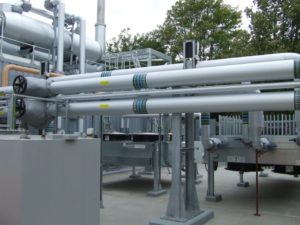 Combined heat and power generated around 6% of UK electricity generated in 2014, according to latest data. “But the technology remains underexploited,” says Chris Marsland, technical director at CHP firm ENER-G.
Combined heat and power generated around 6% of UK electricity generated in 2014, according to latest data. “But the technology remains underexploited,” says Chris Marsland, technical director at CHP firm ENER-G.
Latest data from the department of energy and climate change shows that the total number of CHP schemes increased to 2,066 in 2014, with 11 per cent of systems using renewable fuel, compared to 9.5 per cent in 2013. Some 13 million tonnes of carbon dioxide savings were achieved as a result of displacing fossil fuels.
The amount of ‘good quality’ CHP generated was actually marginally down (0.6%) on 2013. Good quality means output from CHP plant that has been sized so that most of the heat that is generated at the same time as electricity is actually used. Often it is channelled off via heat networks to homes or buildings or to feed industrial processes.
Such schemes are a highly efficient used of fuel, yet CHP remains an underutilised tool in decarbonising the energy system, according to ENER-G.
“It’s good to see CHP providing a significant proportion of UK energy production, but the technology remains underexploited,” said Chris Marsland, Technical Director for ENER-G Combined Power. “There are thousands more organisations that could be saving money and reducing their carbon footprint by using CHP.”
He added: “Combined heat and power is around twice as efficient as conventional power generation and provides cost savings of up to 40% over electricity sourced from the grid and heat generated by on-site boilers. It can also provide a secure off-grid supply in the event of power failure.”
Some companies are reluctant to look at CHP because of relatively long payback periods and high capital outlay. For example, a recent survey by The Energyst found that many boards are reluctant to sign off investments with payback terms much beyond two years.
However, ENER-G claims typical payback on CHP is between three and five years. It touts energy performance contracts as a way of avoiding capital expenditure.
Financiers, including the Green Investment Bank, have also warned that companies which cherry pick only the quickest and cheapest energy solutions risk locking themselves out of bundled solutions further down the track.
Related stories
Financing Energy Efficiency – free report
CHP generators could be paid to stop exporting power
Government ‘should subsidise energy efficiency over renewables and give Esos teeth’
Energy finance ‘too complicated and too expensive’?
Tell us why you struggle to finance energy efficiency
Esos firing blanks on board level buy-in to energy efficiency
Standardisation the key to growing energy efficiency money markets
Click here to see if you qualify for a free subscription to the print magazine, or to renew.
Follow us at @EnergystMedia. For regular bulletins, sign up for the free newsletter.




If you add the scope for cooling with absorption chillers (tri-generation) into this mix, the relative efficiency can increase / payback can decrease even further…there are so many useful applications of this technology that are currently untapped…